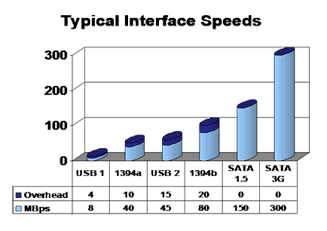Firewire loves you, but some times you need USB. (Because people are cheap and buy cheap machines, you know).
If you're buying a case/dock, I'd go for one with:
- FW 800 (It's 400-compatible, you just need a 400-800 cable)
- eSATA (But if you're on the Mac, none ship with eSATA ports)
- USB (Even my dog has USB and he's not a computer. Also, I don't have a dog)
So you have the best of Firewire and eSATA, but you can still plug your drive to your 20th century friends' machines. (As long as you formatted it as FAT32, I suppose.)
Yes it costs thrice the price of a USB-only case. You get what you pay for.
Some real usage stories:
- I tried running backups both via USB and via FW400, and FW is decidedly faster. (Using SuperDuper)
- Where I work, we had some hard time trying to play full HD uncompressed videos from FW400. FW800 really shines here. If you plan to edit said videos, you're gonna need it.
Sadly I never had the chance to use eSATA, but as pointed by others, it should perform similarly to SATA, which is great.

1USB2 requires the CPU to handle low-level communication details, while Firewire has a discrete controller on the ports which handles the gritty details. I think USB3 overcomes this though by also delegating more responsibility to the USB controllers, and less to the drivers. – Mark K Cowan – 2014-11-02T18:49:34.983
I've been told USB causes more CPU load than IEEE 1394 (a.k.a. FireWire™) – dlamblin – 2009-07-28T10:58:41.260
1I don't know about causing more load, but USB can be slightly CPU intensive. USB performance can possibly suffer during periods of high CPU load. I've seen people who played online games with USB based ADSL modems, and they would experience frequent drop offs while playing because of high CPU load. – EvilChookie – 2009-07-28T15:27:06.527
eSATA is the exact same SATA protocol, with requirements for better cables and higher voltages, and a slightly different connector. – Mircea Chirea – 2010-11-05T16:42:05.093
3Firewire 800 feels nearly as fast as a native internal. – Jay R. – 2009-07-19T04:01:04.763